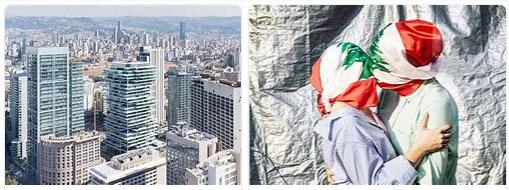French mandate
The history of Lebanon with its current borders and its mixture of Christian and Muslim populations only began in 1920, when the French (who had gained control of the territory thanks to the secret Sykes-Picot agreement, signed between the French and the British during the war) they united under his administration the coast and plain populated by Muslims, and the Mountain, inhabited by Christians, to create Greater Lebanon, under his rule.
For practically the previous two millennia, this territory had always been part of expanding continental empires. Although Lebanon has very rarely formed an independent political entity, the Maronites had developed the view that the Mountain was a country with a history and character of its own. The French had supported this belief, so the Maronites received their mandate very well, with which they also obtained economic and political benefits.
However, the Arab population defended the creation of a Great Arab Kingdom with its headquarters in Damascus, which reflected their nationalist aspirations. Its short duration (1918 – 1920) caused that they did not welcome the creation of Greater Lebanon, which led to armed revolt. The French favored the writing of the Constitution of 1926, which would serve as the basis for a future independent state. However, full independence was not achieved until 1946, when the last French troops were evacuated.
Independence
The French administration established an economically viable state, but with politically threatening religious conflicts in addition to having established unclear borders, especially with Syria to the north. In 1943 the Maronite representatives reached an agreement to share power (the National Pact) with Sunni Muslims and other minor groups. The real power, however, was held not by the elected leaders, but by an increasingly prosperous business elite and a class of quasi-feudal lords, defended by their own armies.
Presidents have very often been at the mercy of forces and groups beyond their control, although both Camille Chamoun (1952 – 1958) and Fuad Chihab (1958 – 1964) of the 1950s From opposite political perspectives, they established a rigid control of the country, which allowed – under Christian control of the key positions of the state – the economic flourishing from financial speculations, which encouraged business and foreign investment, while at the same time produced an outstanding tourist development. However, very little of this prosperity reached the population, in which the number of Shiites was increasing, and their discontent exploded in demonstrations and riots, and, after 1975, in a civil war.
The civil War
In 1975 fighting began between the Lebanese Muslim factions and the Maronite-dominated Christian factions. The central government ceased to function heavily armed militias reduced Lebanon to anarchy. The Palestine Liberation Organization (PLO) joined the Muslim side in early 1976 and Syria (concerned about the Israeli reaction) intervened in support of the Christians and against the PLO. Beirut was divided by a ‘Green Line’ from east to west, separating the Christian north from the Muslim south. In June the Arab League imposed a truce, entrusting the Syrians with maintaining peace.
Despite everything, the violence continued and in 1978 Israel invaded southern Lebanon in an attempt to eliminate Palestinian bases. A UN force replaced the Israeli troops, but continued to assist the Maronites and attack PLO bases. In June 1982, Israel, fearful of the Syrian rise, invaded Lebanon, a country located in Asia according to EZINERELIGION. By mid-August, after US mediation, the PLO fighters agreed to leave Beirut and many were evacuated to other countries. Later that month, with Israeli troops surrounding Beirut, the Lebanese Parliament elected Bechir Gemayel as president, after his assassination in September, his brother Amin Gemayel was elected. to replace you.
Israel murdered 1,000 Palestinians in the Sabra and Shatila refugee camps, in the Israeli-occupied part of West Beirut, with the help of Israeli-funded militias. For this reason the Israelis withdrew to southern Lebanon, and an international peacekeeping force was established in Beirut. Muslims were suspicious of Western units supporting a Christian-led government; After more than 300 American and French soldiers were killed in an attack on October 23, 1983, Western troops withdrew in February 1984.
In the resulting power vacuum, factional fighting continued until in 1985 the Israelis withdrew leaving a “safe zone” in the south controlled by their Christian allies, the South Lebanon Army (ESL). The Iranian- and Syrian-backed Shiite Hezbollah(Party of God) fought for this area with the ESL, having rejected a Syrian-sponsored peace agreement in December 1985. The Israelis continued to raid the facilities of the PLO in the south, and deteriorating conditions in Beirut led Syrian troops to occupy the Muslim sector in 1987 to end the enmity between the Lebanese and pro-Palestinian Muslims.
When Gemayel’s presidential term expired in September 1988, he appointed Christian general Michel Aoun to head the government. As the Lebanese leaders were unable to find a new president, the warring factions established their own administrations. In October 1989, Lebanese negotiators, meeting in Saudi Arabia, agreed to reform the 1926 Constitution that gave power to Muslims; Aoun rejected the project, threatening the permanent partition of Lebanon. On November 5, the Parliament, mainly Muslim, ratified this reform and elected René Moawad president. He was assassinated 17 days later, and Parliament elected another Maronite, Elias Haraui, in his place.
In October 1990, Syrian troops based in East Beirut defeated forces loyal to Aoun. The Lebanese army, backed by Syria, subsequently regained control over a large part of the country, disarmed militias and drove the PLO from its strongholds in southern Lebanon. The war had claimed the lives of more than 150,000 Lebanese since 1975.
